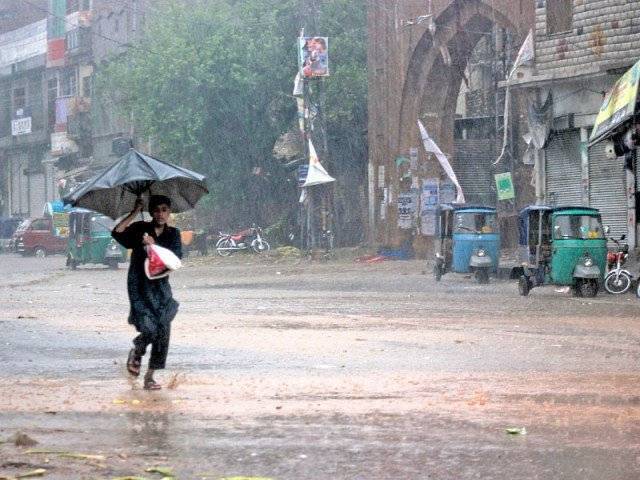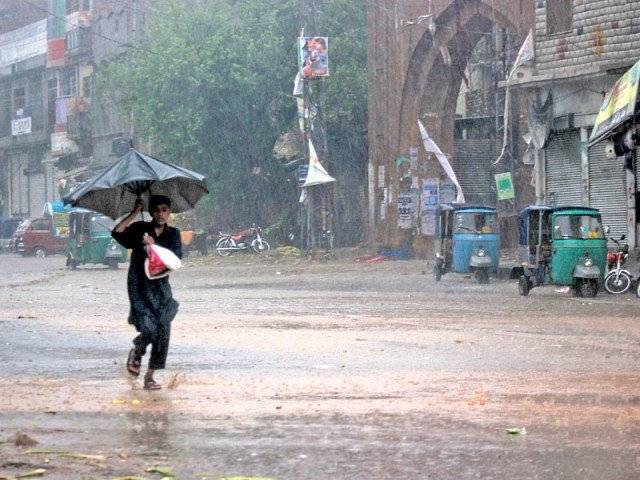
On Monday morning, Karachiites woke up to the pleasant sounds and smells of the first rainfall of the monsoon season.
Overjoyed by the downpour that has become a rarity of sorts for the city, they set out to enjoy the rain, which also did much to break the heat spell that had gripped the city over the last couple of months.
Monsoon plantation: Mayor calls for clearing bushes, wild shrubs
The joy was, however, short-lived. Roads soon became inundated. Power was cut off. Water supply too broke down in the absence of electricity. What was meant to be a divine blessing soon turned into chastisement for Karachiites.
Alerts
At least a week ago, the Pakistan Meteorological Department had sounded the alarm on potential urban flooding due to heavy downpours in Karachi and other parts of Sindh starting July 29.
The municipal authorities were allegedly put on high alert, with the local government minister, Saeed Ghani, directing the local bodies to ensure the cleaning of the stormwater drains.
Come Monday, the authorities' rhetoric was laid bare as the city soon choked, with rainwater accumulating on major thoroughfares, causing difficulty to pedestrians and motorists alike.
Citizens lamented the failure of the city's administration in coping with the first monsoon rains. On the other hand, authorities claimed they are working round-the-clock to cope with the situation.
Measurements
The system of monsoon rains based on low wind pressure in the Bay of Bengal entered Sindh from Indian Rajasthan on the night of Sunday due to which heavy and moderate rains began at different places in the city at around 5am on Monday. The rains began from the suburbs of the city after which the system spread all over the city and rains continued all day long.
The highest rainfall was recorded in Surjani Town at 69.4 millimetres and the lowest in Landhi at 15 millimetres. According to the Met department, this was the highest rainfall recorded in the city after 2017, when the city had received 130 millimetres of rain in a single day.
According to the Chief Meteorologist, Sardar Sarfraz, the current process of monsoon is expected to continue till Wednesday evening, with intermittent heavy and moderate showers. On Wednesday, winds will blow at a speed of 45 km/hour from the sea's south-western direction.
Visibility during heavy rains was reduced from 6 km to 1.5 km. According to the Met department, the maximum temperature on Monday in the city was recorded at 28 degrees Celsius - at least six points down from the previous day.
The Met department has predicted rains with thunder and storm today (Tuesday).

Power outages
Electricity supply to a major part of the city remained suspended for the whole day, with not even important establishments such as the Sindh Secretariat, Sindh Assembly being spared.
All tall claims of investment of billions of rupees in the electricity distribution system were exposed.
On the night between Sunday and Monday, light rainfall caused six grid stations and more than 500 feeders of the K-electric to trip. Due to the thousands of faults that broke out in the electricity distribution system, power supply to over half of the city was suspended.
Meanwhile, the K-Electric ran a misleading campaign on news sources and social media, claiming all was well and that power had been restored to most areas. Until late Monday night, half the city was deprived of power supply for 12 to 16 hours.
Ammar Ahmed, a resident of PECHS, said that power supply to their area was suspended at around 6am on Monday. Residents continuously registered complaints at the K-electric call centre and via social media, but they received the same standard response that that electricity supply had been suspended due to a technical fault and the staff was busy attending to it.
According to KE officials, the grid stations of Clifton, North Karachi, Orangi Town, Korangi, Dhabeji and Old City areas were shut down completely due while more than 500 feeders tripped. The areas severely affected by the power breakdown include Clifton, Bath Island, Shireen Jinnah Colony, Orangi Town, Landhi, PECHS, Sharifabad, Bahadurabad, Nazimabad, Liaqatabad, Lyari, Old City area, Keamari, Lines area, Malir, Quaidabad, Gulshan-e-Hadeed, Shah Faisal Colony and Model Colony.
The power break down also affected various courts in the city, with the Supreme Court's Karachi Registry and the Sindh High Court (SHC) having to run generators. The accountability courts were affected by the power breakdown since 8am, with the court staff searching for documents and carrying on their work with the help of torch lights.
Irked by the outage, the SC summoned the K-Electric's deputy general manager, who explained that the feeders had tripped due to the rain, suspending the power supply.
He said that they would try to supply electricity to the SC through alternative sources. Most case hearings were adjourned owing to the power outage.
Other parts of Sindh
The first monsoon cloudburst lashed in districts of Hyderabad, Mirpurkhas and Nawabshah divisions on Monday, with the Hyderabad Electric Supply Company (HESCO) depriving almost the entire region of electric supply.
Rainfall started around Sunday midnight and continued through Monday evening. Although roads and streets in urban towns appeared to be drowned in water, the supply of water for domestic consumption ground to a halt.
At least five people, including two children and as many women, were reportedly injured in separate incidents of roofs collapsing. The torrential downpour also disrupted the telecommunication system and services of cellular networks were affected.
Power outages, which lasted for up to 18 hours till the filing of this news, blocked drainage systems in urban and semi-urban areas consequently creating flash floods and paralysing life in all the cities. Hyderabad received the highest amount of rain at 188 millimetres, which is the largest downpour the city has received in over a decade in just 16 hours, followed by Thatta district where 179mm was recorded.
According to the Pakistan Meteorological Department, Chorr town of Umerkot district received 122 mm, Tando Jam town of Hyderabad 106 mm, Noshehro Feroze 97 mm, Badin 66 mm, Tharparkar 53mm, Mirpurkhas 48 mm and Benazirabad 45 mm by 6 pm on Monday.
According to the PMD, strong monsoon currents have penetrated the southern parts of the country after they entered from the Arabian Sea and Bay of Bengal. Widespread rains with a thunderstorm with isolated heavy falls have been forecast across Sindh for Tuesday.
Roof collapse
In the incidents of roof collapse in the residential units, three persons including two children were injured in Tando Muhammad Khan and two women in village Sher Muhammad Khaskheli of Kot Ghulam Muhammad. Two men were also injured in Thatta district after falling in a storm drain.
The roads of several villages in Thatta, Umerkot, Noshehro Feroze, Badin and Tharparkar districts were disconnected from the main towns after the rainfall. The historic Badshahi Mosque in Thatta was also inundated with rainwater.
Meanwhile, the Left Bank Outfall Drain, which takes saline water from Punjab and upper parts of Sindh towards the Arabian Sea, kept the farmers in Badin district on pins and needles. The farmers feared that the torrential downpour may cause a breach in the LBOD, similar to the 2011 situation when the breaches in the drain affected some other districts as well besides Badin.
Hyderabad
Receiving one of the highest downpours, Hyderabad presented the look of a drowned city on Monday. The Water and Sanitation Agency, which is responsible for drainage, blamed HESCO for the situation. The HESCO's spokesman Sadiq Kubar confirmed that all the 12 electric feeders powering WASA's filtration plants, water supply and drainage pumping stations have remained shut along with all the other 80 feeders in Hyderabad.
"The feeders have been shut for safety reasons," said Kubar, denying that any fault in a grid station or feeder had led to the suspension of power supply. Explaining a recent statement of HESCO's chief Abdul Haq Memon in which he asserted that there would no load shedding during rainfall, Kubar said Memon meant that there would be no fault in the system.
Despite declaring a rain emergency, the district administration, Hyderabad Municipal Corporation, Qasimabad Municipal Committee and WASA did not appear prepared to deal with the situation.
Bracing monsoon season: Chaos as rain continues to lash parts of Punjab
The Wadu Wah road was cut three feet wide and four feet deep to given passage to the overflowing Wadu Wah, a water channel turned into a massive drain in Qasimabad, towards a large ground.
The underpasses in the city remained submerged in up to 10 feet water and all the low lying areas were drowned in up to two to three feet water. Even the city's main intersections remained submerged in knee-deep water.
The rainfall stopped by 4.30pm in Hyderabad but almost the entire city remained without power by 9 pm. The water shortage also hit the whole city as WASA kept its filtration plants and pumping stations out of operation due to the outage.
Published in The Express Tribune, July 30th, 2019.

























1714024018-0/ModiLara-(1)1714024018-0-270x192.webp)









COMMENTS
Comments are moderated and generally will be posted if they are on-topic and not abusive.
For more information, please see our Comments FAQ